The world could probably use a few more firefighter arcade games since it seems like just about all of them are astonishingly good. Mr. Rescue is no exception to the rule with its intense gameplay and some charmingly ridiculous self-aware humor. Between putting out fires, collecting upgrades, monitoring your water and heat meters, and, most importantly of all, rescuing people by tossing them out of windows, there is a lot to keep track of and little time to spare.
Mr. Rescue works particularly well because it maintains a steady pace with straightforward gameplay even though there is a lot to keep track of, making this a game which is easy to learn and extremely hard to master. Each level is divided into sets of three floors and, as the fire chief will frequently tell you between sets, the most important task is to rescue everyone. The trick here is that the floors are procedurally generated and you aren’t given any indication as to just how many people are scattered around in each set and you gain a strike for each person you fail to rescue; accumulating too many strikes results in an immediate loss so you need to be thorough even while under time pressure from the fire. You gain a point bonus for tossing three or more civilians in a row out of windows to presumed safety, but this bonus is heavily dependent on just how many people the procedural generation decides to place on the same floor as each other so it generally depends more on luck than anything else.
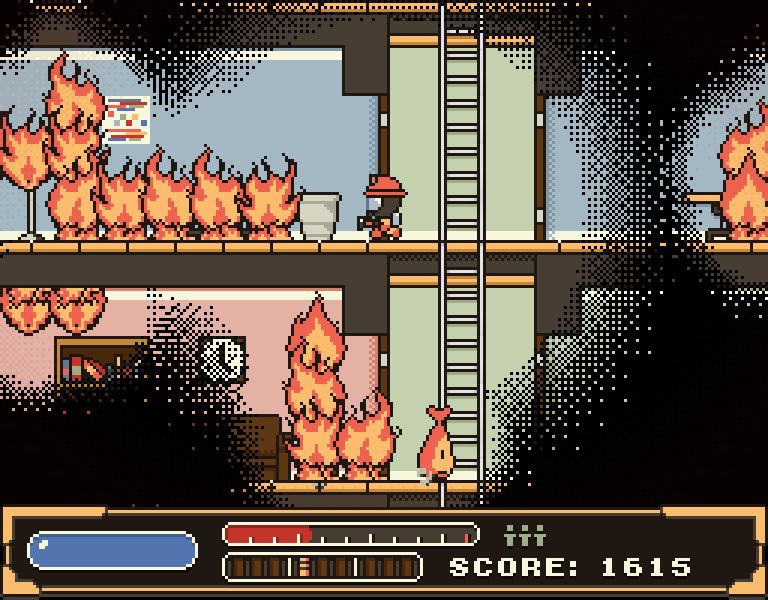
The process of rescuing people is made significantly more difficult by the fire and at times even the civilians themselves, though the building layouts help to counterbalance things. Fire is a major issue in two ways. First, the thermometer serving as your health bar gradually fills over time, but it fills more quickly if you are close to fire and rises at a deadly rate if you are physically touching fire, making it an astonishingly bad idea to try to heroically charge through the flames for just about any reason. Secondly, each fire tile grows over time and eventually spreads to one of the four tiles adjacent to it, which leads to groups of flames rapidly getting out of control. Though you don’t need to put out fire, dousing troublesome spots early on can save you a lot of trouble because fire can spread between floors and each floor is three tiles tall; the bottom two tiles can be put out while standing or jumping, but the top tile can only be hit with water by getting closer and standing directly underneath it. As to the civilians, they walk left and right, turning around when they get near fire or a door, and they won’t accidentally walk into fire on their own, but your speed is reduced while you’re carrying someone and they will more than happily place themselves between you and flames while you’re trying to clear a path, which can lead to accidentally setting them on fire after pushing them into the flames with water. Thankfully, you actually have a good amount of mobility despite the fire constantly spreading and blocking off paths because there is always at least one ladder, and often more than one, connecting the floors and fire escapes are present on either side of the building to connect all three floors in each set, making it possible to more easily reach rooms on either end even large clusters of flames block them off from more central paths.
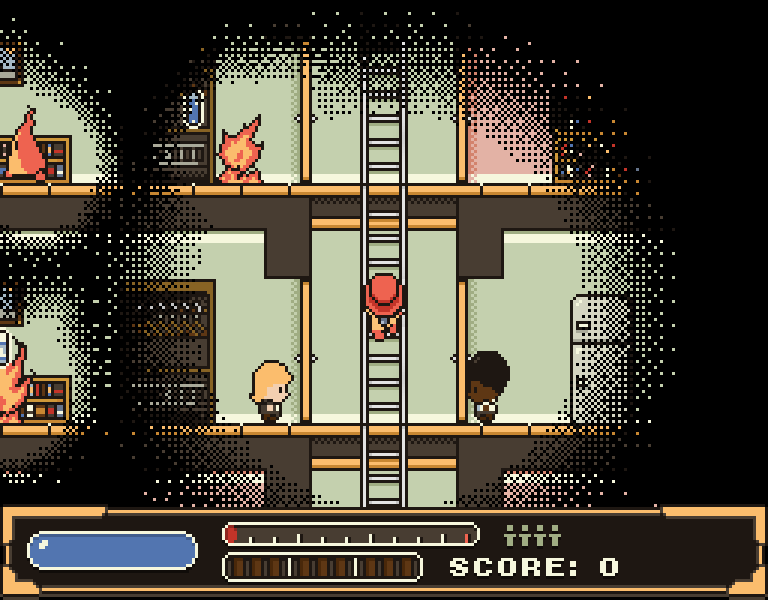
Your water tank and various upgrades are invaluable assets. Mr. Rescue is capable of spraying water very far across the screen, but he can only shoot in a straight line and your tank’s water supply drains away. Monitoring your water may very well be at least as important as moving quickly because, while the water in the tank refills over time, if the tank becomes completely empty you won’t be able to make use of your watery weaponry until it refills to the top, wasting precious seconds as the flames continue to grow. Despite its limitations, the water tank is actually rather versatile. It can be used to break doors and windows, the former of which is necessary for travelling between rooms and can either be beneficial if you need to give a civilian more room to move around in, or dangerous if a room contains a fiery enemy as foes normally cannot break down doors on their own. You can also use the hose to deliberately push around civilians if picking them up and throwing them is too slow or dangerous and shooting while standing on a window ledge will let you hit fire above the floor without needing to jump.
As for upgrades, every set of three floors contains three coolants and one of four other boosts. Coolant is the equivalent of a healing item as it removes a good chunk of heat from your bar; you’ll sometimes need to pass up on a coolant or two if it would mean taking more damage getting to it than it would actually heal, but it is important to scout around for it while looking for civilians because your temperature will definitely hit its limit if you don’t. Most of the other upgrades are permanent, can stack up to three times each, and include an extremely useful water regeneration boost, a heat resistance upgrade (i.e. more health), and a tank capacity upgrade which carries a bit of risk to it because the increased size means needing to wait longer for the tank to refill if you let it completely drain. The final upgrade, a reserve tank, works a bit differently because it doesn’t stack multiple times and it gives you a second bar for your tank capacity which goes away if you use up all of it; the reserve tank is a more limited upgrade than the other three, but it can save you from disaster if you are in a situation where you need to keep up the pressure and can’t afford to let the tank refill.
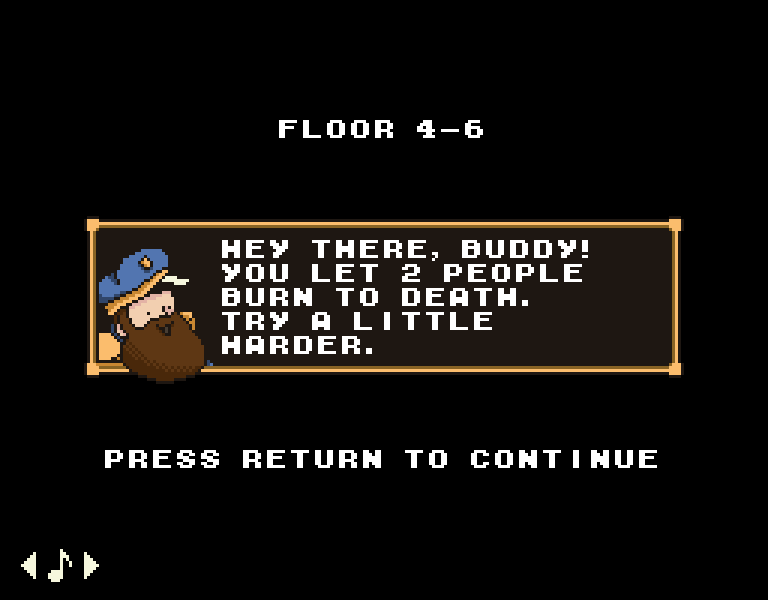
The most impressive part about Mr. Rescue is just how well all of its systems merge together and complement each other. For example, you can probably tell from the screenshots that your vision is limited to a fairly large circle around Mr. Rescue, yet flames and enemies also help to illuminate the levels, making it possible to see which rooms on other floors contain upgrades or civilians and which rooms can be skipped; the more the fire impedes your progress, the more it helps your search. There are also several gameplay and design rules in place which decrease the dangers posed by the procedural generation. You may not know how many people need rescuing in each set or how close you start to either side, but you know that there will always be at least one person in need of saving, that there will always be exactly four upgrades to find, and that fire escapes will be readily available on either side. An even more useful, and unspoken, rule is the fact that civilians never spawn in the same rooms as enemies, so the mere presence of an enemy in a room is all you need to know that you can safely avoid that room if you need to, though upgrades can still spawn alongside enemies. This is a game which feels great to play because you are constantly making rapid progress either by putting out fire, discovering more of the layout of the current floors, or finding civilians and upgrades; the only downtime present is during the much-needed breaks between floors and the penalty time spent desperately waiting for your tank to refill if you accidentally run out of water.
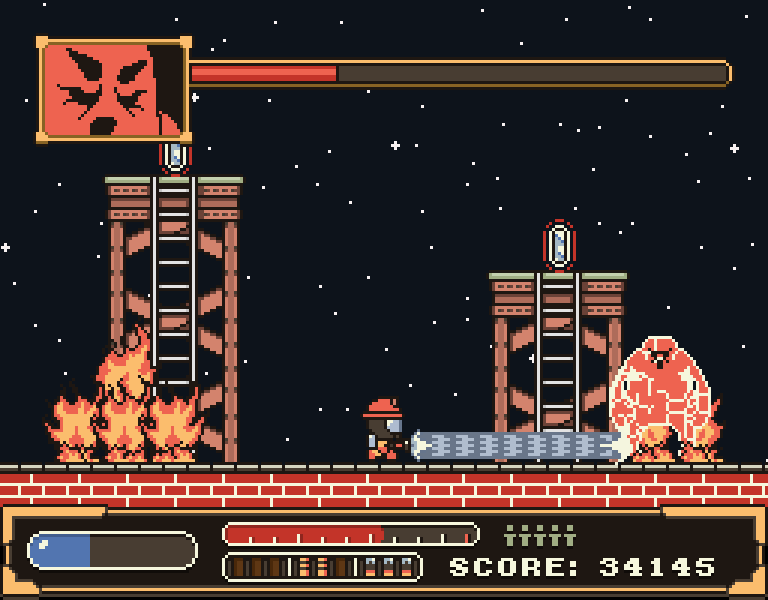
Though the adorably cartoonish graphics and the generally silly atmosphere may lull you into a false sense of security, this game is just about as brutally unforgiving as they come without feeling unfair. Making direct contact with fire even briefly can completely obliterate your chances at finishing a run because of how quickly it will make your heat meter fill. Failing to check even a single room can be equally disastrous as it is possible for two or three people to be grouped together, which will make your strike count skyrocket if you move on to the next set of floors without tossing them out of a window. There are three levels to choose from, representing three different difficulties, and even the easiest of the lot will likely take several attempts to complete; I can finish the first level fairly consistently, but still have yet to reach the final floor of the third level to give an idea of how much the difficulty increases and I can’t confirm if anything is unlocked upon finishing the final level. Part of this difficulty increase comes from a simply increase in the number of floors from 21 to 30 to a whopping 42 in addition to a decrease in allowed strikes from 5 to 4 to 3, but that’s not all. Enemies are more frequent on the higher difficulties and the three types include a walking flame which you can stun with water, a hopping flame, and another walking flame which periodically spouts embers and can’t be stunned. In addition to being more commonplace on higher difficulties, more aggressive smoke-colored variants appear on the upper floors of the medium difficulty and can appear right from the start on the hardest level. There also tends to be more fire on the higher difficulties and, while I’m not entirely sure about these last two points, fire seems to spread faster and floors generally look to be wider on medium and especially hard mode. On top of all of this, each level has a boss which you must defeat if you manage to reach the roof. The procedural generation may give this game plenty of replay value, but most players are likely going to need to burn through a good number of hours before they reach the end of the final level even once.
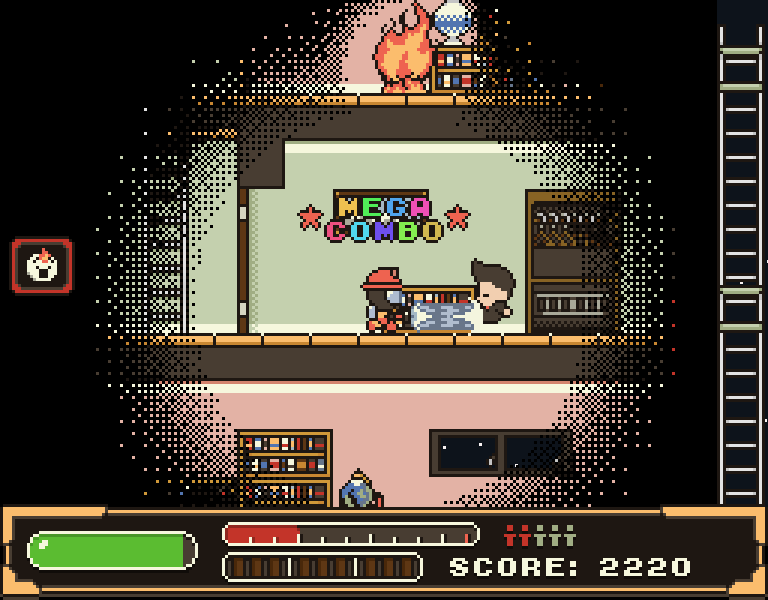
Mr. Rescue has a fast, steady pace, simplistic gameplay complemented by a high degree of challenge, and a ton of charm. It’s a virtually perfect arcade game to play regardless of if you’re looking to kill a few minutes or a few hours.